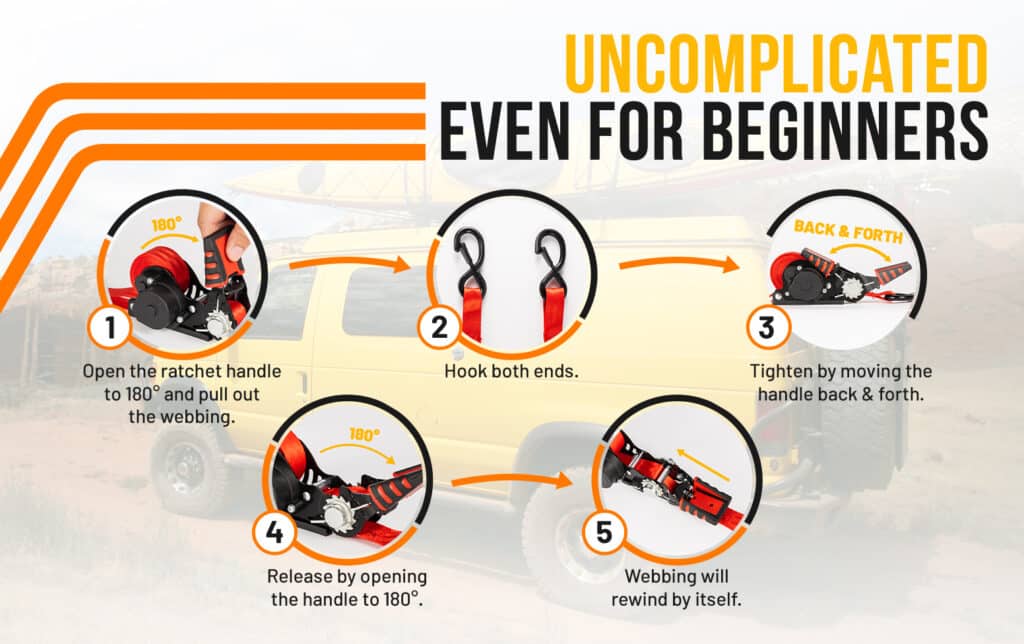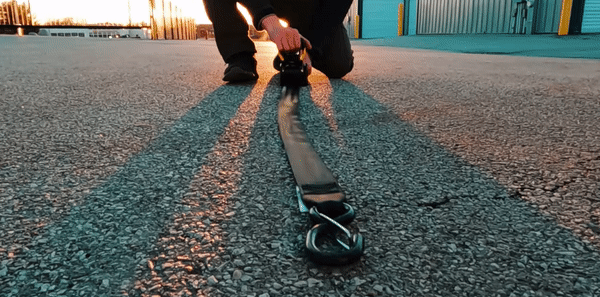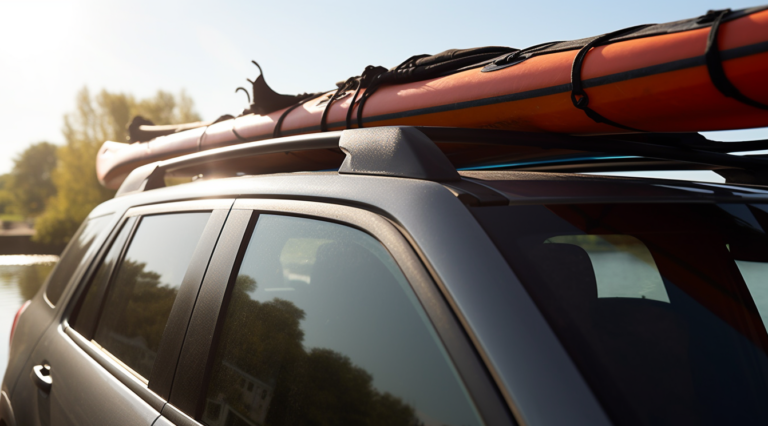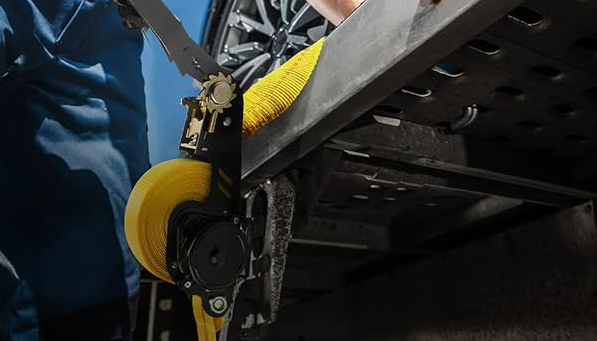Ultimate Guide to Retractable Ratchet Straps (2025 Edition)
(Updated for 2025: part of our Tie-Down Guides Library.)
You know those regular ratchet straps everyone’s got kicking around the garage, the ones that somehow end up in a knot the exact size of a football? Yep, those. They are trusty, they work, and we have all used them a million times to keep everything from couches to kayaks where they belong.
But every time I’m stuffing that loose tail under a bungee cord, I catch myself thinking: There’s gotta be a tidier way to do this. And yep, you guessed it right! That’s when the retractable ratchet straps come in. They are kinda like the seat-belt version of tie-downs. Maybe you have seen a quick demo on Instagram or spotted them at the hardware store and wondered:
- Do they really rewind themselves, or is that marketing hype?
- Are they strong enough to handle my dirt bike?
- What sizes do they come in, and does “1 inch” versus “2 inch” actually matter?
- Are they worth swapping out the jumble of straps living in my truck bed?
If any of that sounds familiar, you’re in the right place. Grab a drink, park it for a few minutes, and let’s dig into the nuts and bolts, literally of retractable ratchet straps. By the end, you’ll know exactly when they’re a game-changer, when the classics still shine, and how to pick the right strap (and size) without overthinking it. Ready? Let’s get to it.
What Are Retractable Ratchet Straps?
Okay, picture a regular ratchet strap, but give it a built-in rewind super-power, kind of like if your car’s seat belt and a tie-down had a very organized baby. That’s a retractable ratchet strap.
- One piece, all the pieces. The webbing is permanently attached to the ratchet body, so you are never hunting for a missing tail or matching a buckle to the right strap again.
- Auto-rewind magic. Press a button or flip a lever and the extra webbing zips back into a tidy little housing. No loose ends, no flapping, no MacGyver-level knot-tying.
- Same muscle under the hood. Inside, it’s still a ratchet. Steel gears, locking pawl, the whole nine yards, so you get the same clamping force you trust on a “normal” strap.
- Choose your flavor. They come in the usual widths (1″ for roof-rack and kayak duty, 1½″ for ATVs, 2″ for heavier stuff) and hook styles (S-hook, flat hook, E-track clip, snap hook, double J hook).
- User-friendly for real humans. Because the strap rewinds into a shell, it stays cleaner, lasts longer, and won’t prank you with mystery knots the next time you open the toolbox.
Short version? A retractable ratchet strap is just a smarter, tidier take on the tie-downs you already know. Same strength, way less drama.
Why Choose Retractable vs. Traditional Straps?
Look, I’m not here to start a strap war. Traditional ratchets still haul half the world’s cargo just fine. But there are a few moments where the retractable version feels like you have jumped from dial-up to fiber internet (or like to the AI world. Well… you get what I am trying to say here right?) If not, here’s a comparison table for you to understand the differences between the old and the new one better!
| Everyday Scenario | Traditional Ratchet | Retractable Upgrade |
|---|---|---|
| Loading in the dark | Fifteen feet of loose webbing twirling in the wind like party streamers. | One click, webbing stays put, flashlight stays in your pocket. |
| Quick errands | Spend more time untangling than actually strapping. | Hook, crank, zip. Done in under a minute. |
| Road-trip pit stops | Loose tails flap, paint gets nicked, you keep re-tucking. | No tails. No flapping. Zero mid-drive drama. |
| Storage | Drawer full of mystery knots and grease stains. | Compact housings that stack like coasters. |
| Longevity | UV, salt, and mud chew the webbing because it’s always exposed. | Webbing lives inside a shell. Stays cleaner, lasts longer. |
So if you’re the “grab-and-go” type of person, or just tired of playing cat’s cradle with nylon straps, retractables save real time and real sanity. Still love your old stand-bys for the big, burly jobs? Keep them! Think of retractables as that handy multi-tool you toss in the glove box: small upgrade, big convenience, and you end up using it way more than you expected.
How They Work (Step-by-Step Guide)
Ready for the 30-second tour? Grab a retractable ratchet strap and follow along. Coffee in one hand, strap in the other. (We are taking our 1 in x 12 ft Retractable Ratchet Straps for example.)
Step 1: Wake it up
Hit the little release button and swing the handle open (about a half-turn for the 12-footers, quarter-turn for the 10-foot guys). Now the webbing pulls out smooth as butter.
Step 2: Hook & stretch
Feed out only what you need, then clip the first hook to something solid like a roof-rack bar, truck-bed tie-down, trailer D-ring, or anything solid. Run the strap over (or around) your cargo and latch the second hook on the far side.
Step 3: Cinch it
Thumb the release again and give the handle a few satisfying pumps. Each click reels in slack and snug-hugs your load. Aim for “guitar-string tight,” not “crush the rails” tight. There’s a sweet spot, you’ll feel it.
Step 4: Lock & roll
Snap the handle flat against the frame. That locks the ratchet and hides every loose tail inside the housing. No flapping, no knots, no mid-drive surprises.
Step 5: Let it go
Done hauling? Pop the release, swing the handle fully open, unhook, and watch the strap zip itself back into the shell. All tidy, ready for the next mission.
That’s the whole show: click, crank, cruise, repeat. No tangled spaghetti, no driveway wrestling match.

Breaking Strength vs. Working Load Limit: The Two Numbers You Really Need to Know
Imagine your strap is a car:
- Breaking Strength (BS) is the red-line on the tachometer, the absolute “engine-blows-up” point your strap can hit once (maybe) before it lets go.
- Working Load Limit (WLL) is the posted speed-limit sign. It’s where you can cruise all day, every day, without cooking the engine…or in this case, snapping webbing.
That’s the whole vibe in one sentence: drive by the WLL, not the red-line.
Want the full nerd-out (safety factors, inspection tricks, even why labels matter)? Dive into the deep-dive article: A Detailed Guide to Breaking Strength vs Working Load Limit, your future self (and everything you haul) will thank you.
Quick-and-Dirty Math
Most tie-downs play it safe with about a 3:1 safety factor. So if you see a strap stamped 3,000 lb BS, you can ballpark the WLL around 1,000 lb. Manufacturers do the division for you (it’s on the label), but the rule of thumb is handy when you’re eyeballing gear at the store.
Why the Two Numbers Exist
- Real-world bumps: Potholes, wind gusts, and panic stops spike the force on a strap way beyond the static weight of your load. WLL bakes in that extra oomph.
- Wear & tear: UV, grit, and general life slowly shave strength off your webbing. The margin between BS and WLL keeps you in the safe zone even after a season of abuse.
- One-and-done vs. everyday: Hitting BS is like popping a fuse: it might save the circuit once, but you’re replacing it afterward. WLL is the number you plan trips around.
Practical Takeaways
- Shop by WLL first. If your kayak plus racks is 85 lb, grab 400–600 lb WLL straps and call it good.
- Leave headroom. The closer you run to the limit, the more often you will need to check tension and inspect for wear.
- Retire tired gear. Nicks, frays, sun-bleached webbing? Treat them like worn brake pads. Cheap to replace, expensive to ignore.
The Advantages of Retractable ratchet straps
1. Saves you so much time
We have an experiment video that a YouTuber, FMJeeping, tested for us. No more to say that the video shows a whopping 2 minutes of strapping all four tires of a pickup truck, and has an insane 1 minute and 30 seconds or so, from unstrapping to storing them in the box.
2. Secures heavier items
Ratchet straps are designed to secure heavier objects, which makes them ideal for items that would be difficult to tow with a traditional bungee cord.
3. Won’t damage your belongings
The soft-grip ratchet system won’t damage your belongings, and the straps can be easily removed when you reach your destination by pulling the lever and done!
4. Safe and easy to use
Retractable straps are safe and easy to use, even for those who are unfamiliar with the straps. You no longer need to tie the knot, clean up, and so on. Everything becomes easy as it can get! It’s the signature.
5. No need to store the cords
Retractable ratchet straps don’t require storage, and they’re easily portable. Everything that is left, retracts back; Not using it? It also retracts back. When it comes to the traditional ones, you’ll need to unknot everything before you connect it to the buckles. Feeling lazy when you’re done using it and not wanting to organize it? then you’ll for sure be dealing with the tangles… Use the retractables!
6. Ideal for a variety of objects
Ratchet straps can be used to secure a variety of objects, from canoes and kayaks to motorcycles and ATVs. Now, depending on what size and weight of the item you want to secure, you’ll need different types of retractable ratchet straps. Different ratchet straps come with their own weight limit and breaking strength. Choose them wisely, or just get the heaviest of all, and you can basically use it on everything!

Disadvantages of Retractable Ratchet Straps
1. Price: Up-Front Cost (But Only a Little)
Retractables usually run a few bucks more than basic ratchet straps or bungee cords. Think of it like paying extra for a cordless drill over a manual screwdriver. You shell out a bit more once, then save time (and frustration) on every job after that. For most folks, the convenience, cleaner storage, and longer service life more than pay back the small bump in price. And hey, you deserve a good strap. Treat yourself!
2. Limited availability
Retractable ratchet straps are not always available and may be limited in distribution. Not a lot of companies carry them, as they still promote the traditional ones more often or so, simply because the retractables are so innovative. This is why Strapinno is trending right now!
3. Finding Your Fit Takes a Minute
Because retractables are sold as one complete unit (ratchet + webbing already married together), you can’t mix-and-match parts the way you might with traditional straps. That means you will want to spend an extra 30 seconds measuring your anchor-to-anchor distance and checking the Working Load Limit before you click “buy.” The good news? Most brands publish a simple size chart. Pick the shortest length that comfortably reaches, or size up if you are on the fence, and you are all set. Two quick measurements now save you a return later.
Different Types & Sizes
Different items need different retractable ratchet straps. Below is what we recommend. And of course, you are always welcome to visit our shop for more color options!
Read more: 3 Best Tools to Pair with Retractable Tie-Down Straps
Retractable ratchet straps
- 1 in x 6 ft: Securing motorcycle, dirt bike and other cargo.
- 1 in x 10 ft: Securing motorcycle, kayak, jet ski, and other cargo.
- 1 in x 15 ft: Securing ATV, Boat, motorcycle, kayak and cargo.
Transom retractable ratchet straps
- 1 7/8 in Dual Lock Transom Retractable Ratchet Strap-Stainless Steel
- 1 7/8 in Two-way Transom Retractable Ratchet Strap-Stainless Steel
Boat trailer retractable ratchet straps
- 1 in x 4 ft Boat Tailer Transom Retractable Ratchet Straps
- 1 in x 2.5 ft Boat Tailer Transom Retractable Ratchet Straps
E track retractable ratchet straps
- Wheel Chock Retractable Ratchet Straps Kit
Heavy duty retractable ratchet straps
- 1.5 in x 20 ft Double J Hook Retractable Ratchet Straps with D Ring
- 2 in x 27 ft Heavy Duty Retractable Ratchet Straps with Double J Hooks
- 2 in x 27 ft Heavy Duty Retractable Ratchet Straps with Flat Hooks
- 2 in x 15 ft Snap Hook Retractable Ratchet Straps (Direct Hook Type)
- 2 in x 16 ft Heavy Duty Retractable Ratchet Straps with Snap Hooks
How to Choose the Right Strap
Picking a retractable strap is kinda like grabbing shoes before a day out, just like you match the pair to the adventure:
1. Start with the Job, Not the Strap
- Quick roof-rack run with a kayak? A slim 1-inch × 10-footer keeps things light and packs small.
- Hauling the side-by-side up a ramp? Bust out the 2-inch heavy-duties cus those J-hooks were born for trailer rails.
2. Check the Weight (Hello, WLL)
Grab the real-world number from your bathroom scale or the owner’s manual, then grab a strap whose Working Load Limit beats that number by a healthy margin. Easy math, zero drama.
3. Mind Your Anchor Style
- S-hook: universal, quick on/off.
- Flat hook / E-track clip: plays nice with stake pockets and enclosed trailers.
- Snap hook: great when you don’t trust bouncy roads.
4. Match Length to Reach. Not Ego
Extra webbing rewinds, sure, but a 20-footer for a moped is like wearing clown shoes to jog. Pick the shortest length that comfortably reaches both anchor points.
5. Consider the Environment
- Saltwater launch ramp? Stainless hardware or a coated housing is your buddy.
- Desert toy-hauler trips? UV-treated polyester webbing shrugs off the sun.
6. Specialized Stuff Exists for a Reason
- Transom straps keep your boat’s stern from pogo-ing.
- Wheel-chock kits hug tires without compressing suspension.
- Dual-lock versions add a second latch when you’re extra-paranoid about bounce.
7. Plan for Spares
Keep one size lighter and one size heavier than your “daily driver” in the truck box. Murphy’s Law loves tie-downs.
Bottom line: match width + length + hook style + WLL to your cargo and call it a day. If you need a cheat sheet, peek at the size list just above, then grab the strap that fits like it was made for the job.
Quick-Start Tutorials
Select your cargo type and jump straight to the step-by-step guide.
Powersports & Vehicles
Outdoor & Misc.
Maintenance & Troubleshooting
Your retractables are tough, but a little TLC keeps them from turning into rusty paperweights. Toss this cheat-sheet in your glove box and you’ll never be left cursing a stuck handle at the trailhead.
Read more: Guide to Maintaining Retractable Ratchet Straps
Give ’Em the 60-Second Pre-Trip Check
- Look: frays, cuts, melted spots, bent hooks. Anything sketchy? Retire it.
- Listen: crank once; a healthy ratchet clicks crisp like a bike freewheel. No click or a gritty grind means it’s time for lube or the parts bin.
- Label: make sure the WLL tag is still readable. DOT officers love those things.
Rinse, Dry, Repeat
Back from a salty boat launch or winter salt roads? Blast the straps with fresh water, flick off excess, and let them air-dry before they rewind. Salt crystals = silent killers.
Fixing a Sticky Ratchet
- Pop the handle open, spray a little silicone or dry PTFE lube into the gear teeth.
- Work the handle a few times. No WD-40 baths (oil grabs grit).
- Still stiff? Check for a bent pawl; a quick tweak with pliers usually frees it.
By the way, we get this email a lot: “What brand of lubricant should I spray on the ratchet so it keeps clicking smooth?” Truth bomb, almost any decent silicone, or PTFE-based dry spray works. Honestly pick whatever is on the shelf at your local hardware shop and you are golden.
When the Spring Won’t Retract
- Soft pull test: tug the webbing and let go. No zip? The spring is gummed up or overstretched.
- Quick cure: Light lube inside the housing + a dozen gentle pulls often brings it back.
- Plan B: If it’s still sluggish, treat it like a traditional strap and coil the tail until you can replace the cartridge.
Webbing Battle Scars: Patch or Pitch?
- Minor fuzzing: trim fuzz with scissors, melt stray fibers with a lighter.
- Deep nicks > ¼ width: time to retire. Cheap insurance against a roadside “yard sale.”
Storage That Doesn’t Suck
- Keep them coiled (or retracted) in a vented tote, not wedged under the spare tire.
- Toss in a silica gel pack to fight moisture funk.
- Once a year, unspool fully, inspect, and re-lube. Let’s call it Strap Spa Day.
Field Fixes for the “Oh No” Moments
- Hook popped open? Wrap a short bungee through the eye as a temporary latch.
- Lost the release knob? A small screwdriver slipped into the slot will free the pawl in a pinch.
- Frayed edge mid-trip? Duct-tape wrap plus edge protector buys you enough miles to get home.
To Sum It Up…
There are definitely more advantages over the dis. I’d go for the retractable ones if I can. It just makes your life easier. If you’re looking for a safe, easy-to-use, and the Standard ones are good to fly with, heavy-duty could also be an option if you’re looking for a better way to secure the heavier belongings, look no further than the Retractables! Be sure to check out our online store for more information on different types of ratchet straps! From there, you’ll be able to decide which would be perfect for your specific needs. It all depends on how big your loads are, how heavy it is, and what you will be using them on. Just make sure to get the right size and type for your specific needs!
Read more: 5 Common Mistakes to Avoid with Retractable Ratchet Straps
FAQs
1. Are retractable ratchet straps better?
Yes, retractable ratchet straps can be better because they’re easy to use and store, and they require no threading or tying the end off before use!
2. How does a retractable ratchet strap work?
It depends on what kind of retractable ratchet strap you use! Generally, all you have to do is open the ratchet handle to some certain degrees, pull out the strap, tie down your item, tighten the strap by pulling the handle up and down, lock the handle, and it’s done!
3. What is the easiest ratchet strap to use?
Retractable ratchet straps are often the easiest to use because they prevent tangling and simplify the process of securing loads.
4. Is one ratchet strap enough?
It depends on the load. One ratchet strap might be enough for lighter or smaller items, but heavier or larger loads typically require multiple straps for secure transport. Same logics with retractable ratchet straps. For example, we recommend using at least four straps to tie down your kayak- two at the front, and two at the back.
5. Should you oil ratchet straps?
You generally don’t need to oil ratchet straps, and in most cases, it’s better to use a silicone-based lubricant if the gears or moving parts feel stiff. Unlike oil, silicone won’t attract dust or grime that could gum up the ratchet or get on the webbing. Some folks do prefer using light machine oil, but keep in mind it can cause the strap to collect dirt and get messy over time especially in dusty or outdoor environments. If you go that route, just apply it sparingly and be sure to wipe off any excess. Either way, avoid getting any lubricant on the webbing itself to keep it strong and clean.







